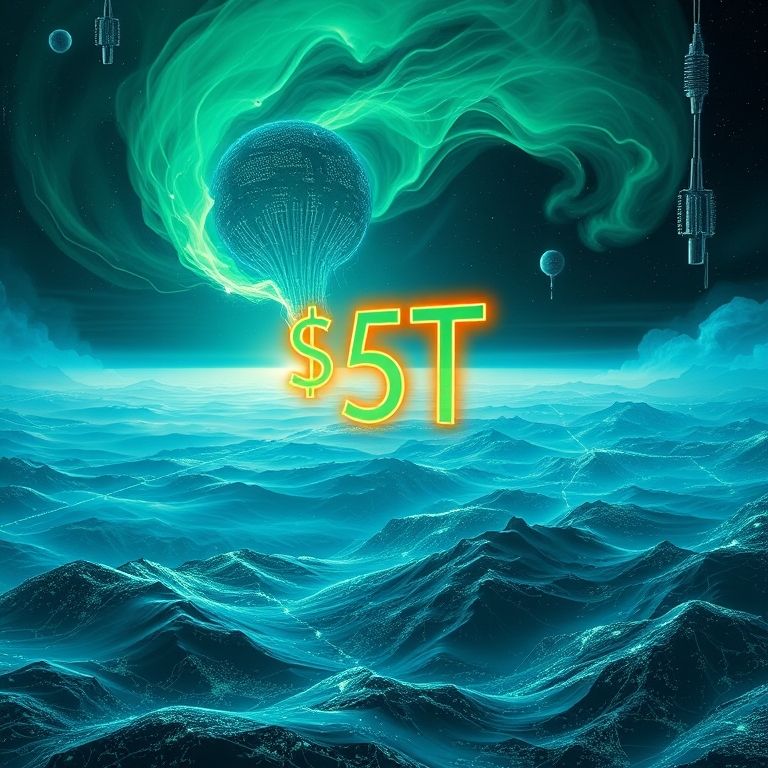Okay, so something pretty wild happened this week that I had to share. You know how everyone’s been talking about AI and all the tech powering it? Well, Nvidia just blew past the $5 trillion market cap mark. Yes, trillion with a “T”! They’re the first company to do it, leaving even giants like Apple and Microsoft playing catch-up. I found this nugget of gold over at Entrepreneur.com, and it really got me thinking.
What’s even more mind-blowing is that Nvidia’s value is now bigger than the combined value of their rivals, AMD and Intel. That’s like one football team being worth more than the entire league! And it’s a clear signal that Nvidia isn’t just in the AI game, they’re defining it.
The question then becomes: why Nvidia, and why now? I think it boils down to a few key things.
Firstly, demand for their GPUs is skyrocketing. Think about it: every AI model, every data center crunching numbers, they all need serious processing power. Nvidia’s GPUs have become the gold standard for this. According to a recent report from Jon Peddie Research, Nvidia holds approximately 80% of the discrete GPU market share. That’s massive!
Secondly, they’re not just about hardware. Nvidia’s also building a complete AI ecosystem, from software platforms like CUDA to partnerships with major cloud providers. This makes it easier for developers to build and deploy AI applications on their hardware. It’s like selling not just the shovel, but the entire gold-mining kit!
Thirdly, they’re ahead of the curve. They saw the AI wave coming and positioned themselves perfectly to ride it. They’ve been investing heavily in research and development for years, and it’s paying off big time.
This isn’t just about one company’s success, though. It’s a sign of the growing importance of AI in our world. From self-driving cars to medical diagnoses, AI is changing everything, and Nvidia is at the heart of it all.
5 Key Takeaways From Nvidia’s Rise:
- AI is a real, tangible force: Nvidia’s valuation proves that AI isn’t just hype; it’s a massive economic driver.
- Hardware still matters: Even in a software-driven world, powerful hardware is essential for innovation.
- Ecosystems are key: Building a complete ecosystem around your product creates stickiness and locks in customers.
- Being first mover advantage matters: Nvidia’s early bet on AI is paying off handsomely.
- The future is compute-intensive: This trend is likely to continue as AI becomes even more pervasive.
FAQs about Nvidia and the $5 Trillion Milestone
- What does “market capitalization” mean? Market capitalization (or “market cap”) is the total value of a company’s outstanding shares of stock. You calculate it by multiplying the stock price by the number of shares.
- Why is Nvidia’s stock price so high? Investors believe that Nvidia will continue to grow rapidly in the future, driven by the increasing demand for AI chips.
- What exactly does Nvidia do? Nvidia designs and manufactures graphics processing units (GPUs), which are used in everything from gaming computers to data centers.
- What is AI, and why does it need powerful chips? Artificial intelligence (AI) involves creating computer systems that can perform tasks that typically require human intelligence. These tasks require a lot of calculations, which are done most efficiently using powerful chips like Nvidia’s GPUs.
- Who are Nvidia’s main competitors? Nvidia’s main competitors are AMD and Intel, both of which also produce GPUs and CPUs.
- Will Nvidia’s stock price keep going up? No one can predict the future with certainty. Stock prices can fluctuate depending on the company’s performance, economic conditions, and investor sentiment.
- Is it too late to invest in Nvidia? That’s a question only you can answer after doing your own research and considering your own investment goals and risk tolerance. Investing in any stock carries risk.
- How does Nvidia make money? Nvidia primarily makes money by selling GPUs and related software and services.
- What are some potential risks for Nvidia? Some potential risks include increased competition, slower-than-expected growth in the AI market, and technological changes that make their products obsolete.
- How does Nvidia being worth $5 trillion affect everyday people in Cameroon? While the direct impact may not be immediately felt, Nvidia’s success signifies the growing importance of technology in the global economy. As AI becomes more integrated into various industries, it could potentially create new job opportunities and improve access to technology in countries like Cameroon, although access would need to be facilitated and equitable.


